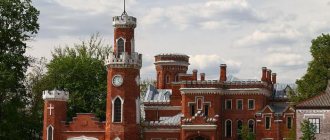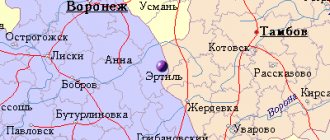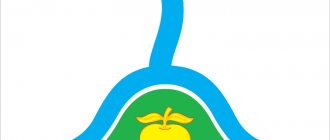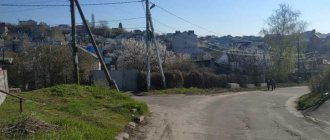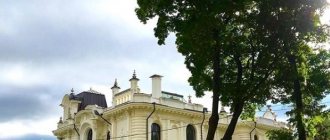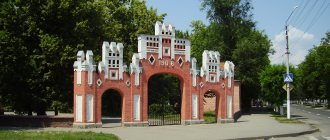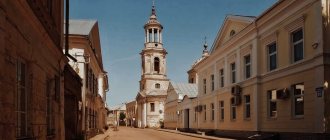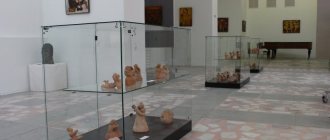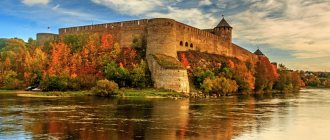| Pavlovsk-on-Don |
Pavlovsk
, a city in Russia, the administrative center of the Pavlovsky district of the Voronezh region, within the Pavlovsky deanery of the Rossoshan diocese. Located on the left bank of the Don, at the confluence of the Osered River, between the Kalach Upland and the Don Belogorye, 45 km from the Podgornoye railway station, 156 km southeast of Voronezh. Population 25.1 thousand (2013)
- On the map: Yandex.Map, Google map
The first settlement on the site of Pavlovsk, called Shirmovskoye
, was founded in 1685. During his first campaign near Azov, Tsar Peter I paid special attention to the area between the Don and Osereda and the swamps, impassable at that time, which by nature itself seemed prepared for a fortress [1]. The Russian state needed fortified points to protect its southern borders, and Cherkasy (Ukrainians) were settled at the mouth of the Osereda for guard duty. They monitored the movements of the Crimeans, who carried out regular raids on the southern Russian regions. In 1708, Peter I ordered Admiral Fyodor Matveevich Apraksin to build a fortress at the mouth of the Osereda, but in the same year the uprising of Kondraty Bulavin began, and the foundation of the fortress had to be postponed. The fortress was founded in April 1709; three thousand captured Swedes were sent to the construction. By decree of Emperor Peter I, the shipyard from Voronezh was moved here. At the fortress, a shipyard was continued for the construction of warships for the Azov flotilla. Peter I visited the fortress several times. In 1711, two warships, a frigate and 10 provision ships were built at the Osered shipyard.
In 1711 to the city of Osered
The garrison was transferred from the Pavlovsk fortress from the north shore of the Azov Sea. After the Prut campaign, which was unsuccessful for Russia, residents of the cities of Azov and Taganrog, given to Turkey, as well as the Pavlovsk fortress on the Mius River, moved here. With a significant influx of civilian population (more than 500 people moved here from merchants alone), residential areas, or “outstadts,” as they are called in historical literature, began to form in the city, to the northeast of the fortress. The formation of residential areas at the beginning of the 18th century, unlike other cities in the province, took place according to a regular plan. Geometrically regular blocks of rectangular elongated shape were bounded by straight streets running along the watershed and perpendicular to the Don (direction southwest - northeast). The central, watershed street (today's Revolution Avenue), starting from the city's eastern gate, was the axis along which the entire composition of the settlement unfolded. Merchants, immigrants from Kazan, brought with them the parish wooden church of the Kazan Icon of the Mother of God, which they immediately installed in their settlement and consecrated in the same year 1711.
On the territory of the fortress, in its southeastern part, at the Peter and Paul Cathedral, there was an administrative zone with an office, an archive, and cash storage rooms. In the center and on the south side there were buildings of “shops” and other warehouse and service buildings. The western part of the fortress - the actual site of ship construction - was free from major construction. Along the Osered River, in the southwestern corner, there were gangways, lifting mechanisms and other devices for launching ships.
In 1713, the Admiralty was transferred here from Tavrov; its construction was carried out under the leadership of Fedosei Moiseevich Sklyaev. During these years, the layout of the Oseredi fortress and the non-fortress territories was finally formed, representing a single shipbuilding enterprise with functional zones and their interrelations.
In 1715, the Osered fortress was renamed the city of Novopavlovsk
, but the name did not stick, and the city began to be called
Pavlovsk
.
The actual territory of the fortress was protected by a defensive rampart with bastions of clear geometric shapes. Its northern border ran along the current street. Pobeda, southern - approximately along the street. Shevchenko, eastern, which had several breaks, ran approximately along the southern border of today's automobile repair plant, crossed the territory of the modern market parallel to the street. Gottwald.
Pavlovsk was a strong fortress and a prosperous city. A two-story wooden royal palace, an engineering yard, a cannon factory, a rope factory, and a powder factory were built here. The city was surrounded on all sides by an oak palisade, and was divided into 2 parts: the castle and the outstadt. Its garrison consisted of 5 infantry regiments and an artillery team. Pavlovsk became a strategically important point from which Russia expanded to the south.
On May 29, 1719, the city became part of the Voronezh province of the Azov province.
Tsar Peter I repeatedly visited the Don town, showing tireless care and attention. Pavlovsk residents always revered this emperor. In the last years of the life of Tsar Peter I, Pavlovsk reached its highest peak. And after the death of the king, the glory, wealth, and prosperity of the city dimmed, as if with the death of the emperor he had lost his protector and patron [2].
In the spring of 1728, as a result of a flood, the city was completely filled with melt water. On the site of the lowland in which the barracks of the Tambov Infantry Regiment stood, the now existing Tambov Lake was formed. In 1737, a severe epidemic raged in Pavlovsk; about half of the city’s residents died. 700 merchants alone were buried. In 1744, a severe fire began in the city, destroying all of Pavlovsk. In 1762, soldiers of the Kyiv and Belgorod infantry regiments were sent to Pavlovsk to cut and float timber. For the purpose of robbery, they again set the city on fire, more than 100 houses burned down. In 1778, a powder warehouse exploded (800 pounds of gunpowder). In 1793, an officer of the Pavlovsk Admiralty, together with three accomplices, completely burned the city.
| Postcard from the series History in photographs: Pavlovsk on Don |
Since 1770, the city was built up according to the architectural plan of St. Petersburg, approved by Catherine II: the central avenue and the streets crossing it perpendicularly - with wooden and then stone buildings, settlements were replaced by wide streets.
After another fire in 1793, only 63 houses remained in the city, the entire city was divided into 30 blocks and had 8 large and 5 small streets. This layout has been preserved to this day [3]. On September 25, 1779, the city of Pavlovsk became a district city of the Voronezh governorship (from 1796 - the Voronezh province). On September 21, 1781, its coat of arms was approved: “Apostle Paul in a silver field.” And in 1786, the general plan of Pavlovsk was approved, developed by Voronezh land surveyors Stepan Provovich Vladykin and E. A. von Kolov and finalized in St. Petersburg.
In 1795, after the abolition of the Admiralty Order, all the state-owned Admiralty buildings still remaining in the fortress and in the city were dismantled and sold. Only the Admiralty Chancellery housed county government offices.
The second plan was drawn up by E.A. von Kolov in 1798 and was somewhat different from the previous one. Further development of the city was based on the plan of 1798.
In total, in Pavlovsk in 1799 there were 320 houses, 18 shops, all of them were wooden. According to the 1800 census, the city's population was only 1,927.
The border of the city on the eastern side (present-day Petrovskaya Square street) was an earthen rampart with redoubts, and the extensive central redoubt at the entrance was called “Paradise Town” and remained until the end of the 19th century. Engineering barriers were built on the southern and western sides of the city to protect against floods.
The population of the city in the 18th and 19th centuries was mainly engaged in trade and melon growing - Pavlovsk watermelons were famous even in Moscow. The first merchants were forcibly brought by order of Peter from Azov and Taganrog, where they had previously been forcibly resettled from Kazan.
In 1871 and 1872, the city suffered major fires. They destroyed three quarters of the city's buildings (363 houses, including the zemstvo government building), after which Pavlovsk began to be rebuilt virtually from scratch. Single brick houses of the first half of the 19th century are being rebuilt, completed and added to.
The historical development of the city, which today constitutes the historical and cultural fund, was formed almost simultaneously - over 30 - 40 years, which determined a single scale, rhythm and repeatedly repeated variations of the “set” of decorative details. It is noteworthy that in Pavlovsk, 150 years after the Admiralty buildings of Peter the Great, at the turn of the 19th-20th centuries. Baroque elements bloomed again in magnificent color - fancy figured attics, gables, platbands.
In the 19th century, industrial handicraft production began to develop. In a word, Pavlovsk was a typical provincial provincial town of Tsarist Russia.
At the beginning of the century, in Pavlovsk, with a population of about 7.5 thousand people, there were 2 primary schools for men, 1 primary school for women, a women's gymnasium, a real school, a theological school and a teacher's seminary. The city becomes a trade and craft center with underdeveloped industry. It was represented by small enterprises: soap factories, tallow candle making, wax candle making, wool washing, tallow making, oil pressing, brewing, distillery, brick, potting and other factories, which employed from 3 to 20 people. Pavlovskaya pier was one of the largest on the Don. It loaded up to 600 thousand pounds of cargo per year: bread, salt, timber, etc. [3]
By 1916, the architectural and urban planning structure of Pavlovsk had developed, largely corresponding to the master plan of 1798. The “Admiralty” part of the city, which was not included in the “regular” layout, was chaotically built up in the 19th century: winding streets here limit irregularly shaped blocks.
Soviet power was established in Pavlovsk on February 11, 1918, on that day the district congress of Soviets of Workers', Soldiers' and Peasants' Deputies opened. The nationalization of buildings was completed in March.
From September 1918 to December 1919, the city was the scene of battles in the Civil War.
On May 12, 1924, Pavlovsky district was abolished, the territory of which became part of Rossoshansky - the city of Pavlovsk with the settlements of Duvanka, Babka, Berezovaya Losevskaya volost, Petrovskaya, Builovskaya volosts completely, as well as Bobrovsky: Vorontsovskaya, Klepovskaya, Livenskaya, Shestakovskaya volosts completely and Losevskaya partially, and Bogucharsky districts - Verkhnemamonskaya, Gnilushenskaya, Gorokhovskaya, Zhuravskaya and Nizhnemamonskaya volosts [4].
On August 27, 1925, Pavlovsk became a rural settlement, but on July 30, 1928, the status of a city was returned, with the center of the Pavlovsk district of the Rossoshansky district, in the newly formed Central Black Earth Region. Since June 13, 1934 - Voronezh region.
In July 1942, the war approached the banks of the Don. Pavlovsk became a front-line city. On July 12, the Stalingrad Front was created, and it began, as Marshals G.K. Zhukov and A.M. Vasilevsky wrote, from Pavlovsk. Later this section was transferred to the Voronezh Front. For almost 7 months the city was subjected to artillery shelling and remained on the front line, but compared to other cities in the region, its development suffered little damage.
| View of Pavlovsk |
In the century Pavlovsk became a significant industrial center.
The city of Pavlovsk is included in the list of historical cities of Russia. There are 40 historical and architectural monuments under state protection.
TOP 5 - what to visit in Pavlovsk in one day
In Pavlovsk, Voronezh region, such types of tourism as excursion, pilgrimage and cultural are developed. The city's main attractions reveal every facet of its tourism potential.
Regional Museum of Local Lore in the Odintsov mansion
- Address: st. May 1, 20.
The most significant museum in Pavlovsk began its existence in 1977, as an amateur institution. Its founder was Eremina E.M. - Pavlovsk local historian, collector and war veteran. In 1991, the museum received state status.
During the excursion, tourists will hear a detailed story about the history of Pavlovsk, from antiquity to the present. All museum exhibits were found on the territory of the Pavlovsk region. The most valuable are fossils of prehistoric creatures, household items from the Neolithic period, a model of the Pavlovsk fortress and photographs of the city from the late 19th - early 20th centuries.
In 1991, the local history museum was located in the mansion of the merchant Odintsov, the most famous architectural landmark of the city. The house was built in the 1890s for the mayor M.S. Odintsova. Despite its venerable age, the building has retained its original appearance and is in excellent condition.
The main façade is decorated with straight and arched architraves in the classicist style, rustication, keystones, and entablatures. Stucco rosettes and garlands have survived to this day without damage. The most notable element of the decor is the porch with openwork casting and figured support pillars.
The museum building is located in the historical part of Pavlovsk and is in perfect harmony with other historical buildings, creating an untouched corner of the 19th century in the center of the modern city.
The building of Olga's women's gymnasium
- Address: Revolution Avenue, 15.
One of the most remarkable buildings in terms of architecture and preservation was built in 1898 by architect A.M. Baranov. The two-story gymnasium is designed in pseudo-Russian style. The facade is richly decorated with snow-white friezes and flies.
The oval windows are framed with platbands with sandriks, the main porch is decorated with kokoshniks and columns. The main building is covered with a barrel-shaped roof, and the two tower extensions have a hipped roof with spiers.
The name of the school refers us to the Romanov family. In 1913, Emperor Nicholas II gave the gymnasium under the patronage of his sister Olga Alexandrovna. In the future, it is planned to install a memorial plaque on the facade in memory of her. Today, a secondary school operates in the Olga gymnasium building.
Pavlovskoye settlement
- Address: .
The 18th-century fortress, which became the source of Pavlovsk, is today located outside the city, about two kilometers away. Initially, the fortress, like the city itself, was called Osered - after the Osered River. The origin of this Golden Horde word remains unknown.
The huge defensive structure was built from 1709 to 1711. Swedes captured near Poltava. Currently, only barely noticeable traces remain of the once impressive structure.
The territory of the settlement occupies about 13 hectares. No excavations have been carried out here, but this gap will soon be filled. It is difficult to imagine how many valuable artifacts that shed light on the formation of ancient Ocerd that scientists will have to find.
Memorial Complex
- Address: 1 May Street.
This popular attraction serves as a reminder of the military history of Pavlovsk. The years of the Great Patriotic War left many scars on the walls of the city, as well as on the hearts of its inhabitants.
For six months the city was on the front line, endlessly exposed to German attacks. In January 1943, Soviet troops managed to liberate Pavlovsk from the Nazis. More than 20 thousand citizens went to the front, and nine thousand did not return to their homeland.
In 1943, a mass grave was created on the territory of the city, in which the soldiers who defended Pavlovsk found peace. In the 1970s, a memorial complex was opened on this site. In its center is a bronze figure of a woman who raises her hands to the sky. To her left, a young soldier knelt on the grave of his comrades.
The Eternal Flame is lit at his feet. Parallel to it stretches a row of busts of Heroes of the Soviet Union - natives of Pavlovsk. The author of the project was the sculptor I. Dikunov. Today, the memorial square is the center of the patriotic life of the city.
Cultural life of the city of Pavlovsk
A visit to Pavlovsk theaters, which embodies the modern culture and age-old traditions of the city, will add variety to the excursion program.
Palace of Culture "Sovremennik"
- Address: 22, Severny microdistrict.
The Palace of Culture was built in the city of Pavlovsk in 2014. The modern building in the constructivist style decorates a large square with fountains, where public events are also held.
The infrastructure of the cultural center includes an auditorium with 450 seats (this is the largest theater and concert venue in the region), a dance hall with a glass roof, an anti-cafe, and a library.
Children's creative clubs operate at the recreation center. Here children learn music, dance, arts and crafts, stagecraft and much more. The Palace of Culture encourages initiative, self-expression and creative development.
Cinema "Rodina"
- Address: ave. Revolutions, 102.
"Rodina" is a cinema founded in the Soviet years. For many years it has been the center of youth life. Despite its age, the cinema keeps pace with modernity. Visitors note the high level of comfort and attractive design of the auditorium. The building also houses a family café where you can grab a bite to eat after your session.
Which museums in Pavlovsk should you visit?
There are many museums in Pavlovsk. Each exhibition helps to gain a deeper understanding of its culture, history and natural heritage.
Museum of the Navy
- Address: ave. Revolutions, 14.
The museum was founded in the early 1990s on the basis of the “Station of Young Technicians”. Initially, the museum exhibits were models of ships collected by members of the circle, but soon the exhibition was supplemented by models donated by local collectors.
Gradually the museum expanded, delving into the history of the Russian navy. Today here you can not only look at miniature copies of ships, but also see naval uniforms from different times and learn about the military hierarchy.
The museum is of great value for Pavlovsk, a city in whose shipyard the best ships of the Russian Empire were created.
Museum of Nature of the Don Region
- Address: Pokrovskaya street, 6.
A modest museum dedicated to the nature of the Don River. Here is a collection of plants, stuffed fish, paintings of landscapes, as well as recreated areas of the landscape: forests, fields, creeks. The museum is small, but cozy, as its guests note. It employs people full of enthusiasm and love for the nature of their native land. Their stories make the excursion even more exciting.
Urban Pavlovian architecture
Ancient buildings preserve the memory of what Pavlovsk was like one hundred and two hundred years ago, about the people who lived in it, and about the eras through which it passed. Such houses are not perceived as background; they deserve full attention.
Former real school
- Address: st. May 1st, 13.
The real school building was built in the 19th century. It attracts attention with its massiveness and monumentality. The facade is decorated with rows of frequent rectangular and oval windows without frames. The risalit is decorated with an elegant attic and an archivolt above the central window.
Half-columns add the finishing touch to the design of the facade, and the composition is crowned with a huge dome with a sculptural spire. Currently, the building houses a pedagogical school.
Fire Tower
- Address: st. K. Gottwald, 7.
It is impossible not to pay attention to the old fire tower. The ordinary red brick building is topped off by an attic with a false window. Directly above it rises a wooden hexagonal tower under a spire.
The fire department was founded at the end of the 19th century and is still active today. On the massive gate you can see red stars preserved from Soviet times.
House of merchant Merkulov
- Address: st. Voykova/st. Victory.
Merkulov's house is the second most beautiful example of a merchant mansion after Odintsov's mansion. The building is designed in eclectic style.
On the red brick façade, whitewashed decorative elements stand out: platbands with triangular sandstones, rusticated stone, brackets, flies and an archivolt with weights above the dormer window.
The merchant Merkulov was one of the richest residents of Pavlovsk. Many buildings in the city are associated with his activities.
Factory management house of merchant Merkulov
- Address: Voykova street, 10.
The Merkulov plant was managed from a one-story brick building. It attracts attention with its unusual shapes: hexagonal bay windows and polygonal domes. Decorative elements include rusticated trim, molding and attics. Today this building houses shops.
Former religious school
- Address: Pokrovskaya street, 12.
The building, which served as a religious school two centuries ago, is an excellent example of the pseudo-Russian style.
The first thing that catches your eye is the pointed towers that complete the façade. The remaining decorative elements (flies, kokoshniks, sandriks and friezes consisting of folk patterns) give the building an airy, elegant look.
The theological school operated until 1917, after which it housed educational institutions of a different profile. Today there is an agricultural technical school here.
The house where A.S. stayed Pushkin
- Address: Revolution Avenue, 16.
Pavlovsk residents are proud of the legend that Alexander Pushkin stayed in their city in 1829. During his trip to the Caucasus, the poet passed the Voronezh region. He made entries in his diary: he scolded the roads, described the Voronezh steppes, and mentioned Yelets and Novocherkassk.
If you plot the route based on these notes, then you can say with confidence that at some point Pushkin passed through Pavlovsk. Perhaps the poet did not even leave the carriage. On the other hand, he could spend the night in the city.
Pushkin's supposed stopping place is the hotel of the merchant Antonov - the most fashionable establishment in Pavlovsk at that time. The legend about Pushkin’s stay in the city cannot be verified. However, on the façade of the former hotel there is a memorial plaque on which it is written: “In 1829, A.S. passed along this street. Pushkin."
Topic: Sights of the Voronezh region
Born and lived in the city
- Martynov, Mikhail Filippovich (1863-1902) - bibliophile, collector
- Raevsky, Alexander Andreevich (1869-1928) - teacher, associate professor at Moscow State University, professor of law at Tomsk and Kharkov universities
- Voskoboynikov, Mikhail Mikhailovich (1873-1942) - zoologist
- Dubyansky, Vladimir Andreevich (1877-1962) - Doctor of Biological Sciences, professor, member of the Geographical Society of the USSR
- Zamyatnin, Sergei Nikolaevich (1899-1958) - candidate of historical sciences, archaeologist, collector
- Alexy (Konoplev) (1910-1988) - Master of Theology, Metropolitan of Kalinin and Kashinsky
- Vorvulev, Nikolai Dmitrievich (1917-1967) - opera singer, People's Artist of the USSR (1956)
- Saenko Ivan Ivanovich (October 17, 1983, Maslovka village, Voronezh region, spent his childhood in Pavlovsk) - Russian football player, midfielder. Bronze medalist at the 2008 European Championship as part of the Russian national team. Honored Master of Sports of Russia (2008).
- Azarov Igor Aleksandrovich (January 21, 1961) - Soviet and Russian composer and singer,
- Prokopenko, Igor Stanislavovich (February 8, 1965) - famous Russian documentarian and television journalist.
Beautiful churches in Pavlovsk
An integral element of the development of Pavlovsk and its cultural life are religious complexes. All of them were built in the 18th century and, together with the city, went through difficult times.
Church of the Kazan Icon of the Mother of God
- Address: ave. Revolutions, 25.
The Kazan temple stands at the origins of the city. The first wooden church was built in 1711 at the same time as the fortress. Half a century later it burned down. In the 1770s, a new stone building in the Baroque style was built on this site.
In subsequent centuries, the temple was rebuilt many times. The only element left untouched was the bell tower. It is a two-tier tower of the quadrangle type, topped with a golden tent under a spire. At the beginning of the 20th century, the main building acquired the features of Russian-Byzantine architecture.
During the Soviet years, the temple was not operational. Worship services resumed only in 2003. Since then, the Kazan Church has received parishioners and actively participated in the spiritual and social life of the city.
Church of the Intercession of the Blessed Virgin Mary
- Address: Pokrovskaya st., 15.
The predecessor of the modern church was a wooden building, the parishioners of which were officers of the Yelets regiment. This building was erected in 1714 and operated until 1783, when the church was rebuilt in stone. The next reconstruction took place in the 1850s. During the work, the temple acquired the features of a pseudo-Russian style.
Since then, the kokomar ceilings, kokoshniks, turrets with flies and arched sandriks have been preserved. The church once ended with an octagon under the dome, but this tier was demolished in the 1930s along with the bell tower.
The church resumed its activities in 1944. During restoration work, a new bell tower was erected on its territory, but according to a different architectural design. In addition, the dome was restored. Now the temple operates and is one of the historical attractions of Pavlovsk.
Cathedral of the Transfiguration of the Lord
- Address: Pokrovskaya st., 9.
Just like all the churches of Pavlovsk, the cathedral was originally wooden. In 1780, the building was rebuilt in stone, and 20 years later a three-tier bell tower appeared next to it.
The cathedral acquired its modern features in the first half of the 19th century, when the Voronezh architect V.I. was engaged in its expansion. Egorov. For a long time, the cathedral was the pearl of Pavlovian architecture. The magnificent building in the classicist style amazed with its monumentality.
The main massif ended with a six-piece structure under a massive dome with a belvedere. The bell tower rose into the sky like a tall gilded spire. Today this cathedral can only be seen in ancient photographs.
In the 1930s, the temple was closed and underwent reconstruction, which almost completely destroyed its original appearance. In 1948, the House of Culture settled in the building, which existed until 2014. The Sovremennik House of Culture moved to a new building, and since then there has been a plan to restore the cathedral.
Today, all that remains of the once majestic complex is one two-story building, which in no way resembles a church building. Behind him rises the bell tower. Empty windows gape in the tower, darkened by time. The frame of the spire is still visible on the flat roof.
It is unknown whether the cathedral will be restored. One way or another, its ruins are a monument to city history.
Be sure to see: Sights of Voronezh
An excerpt characterizing Pavlovsk (Voronezh region)
At one of the stations he overtook a convoy of Russian wounded. The Russian officer driving the transport, lounging on the front cart, shouted something, cursing the soldier with rude words. In the long German vans, six or more pale, bandaged and dirty wounded were shaking along the rocky road. Some of them spoke (he heard Russian dialect), others ate bread, the heaviest ones silently, with meek and painful childish sympathy, looked at the courier galloping past them. Prince Andrei ordered to stop and asked the soldier in what case they were wounded. “The day before yesterday on the Danube,” answered the soldier. Prince Andrei took out his wallet and gave the soldier three gold coins. “For everyone,” he added, turning to the approaching officer. “Get well, guys,” he addressed the soldiers, “there’s still a lot to do.” - What, Mr. Adjutant, what news? – the officer asked, apparently wanting to talk. - Good ones! “Forward,” he shouted to the driver and galloped on. It was already completely dark when Prince Andrei entered Brunn and saw himself surrounded by tall buildings, the lights of shops, house windows and lanterns, beautiful carriages rustling along the pavement and all that atmosphere of a large, lively city, which is always so attractive to a military man after the camp. Prince Andrei, despite the fast ride and sleepless night, approaching the palace, felt even more animated than the day before. Only the eyes sparkled with a feverish brilliance, and thoughts changed with extreme speed and clarity. All the details of the battle were vividly presented to him again, no longer vaguely, but definitely, in a condensed presentation, which he made in his imagination to Emperor Franz. He vividly imagined random questions that could be asked of him, and the answers that he would make to them. He believed that he would immediately be presented to the emperor. But at the large entrance of the palace an official ran out to him and, recognizing him as a courier, escorted him to another entrance. - From the corridor to the right; there, Euer Hochgeboren, [Your Highness,] you will find the adjutant on duty in the wing,” the official told him. - He takes you to the Minister of War. The adjutant on duty in the wing, who met Prince Andrei, asked him to wait and went to the Minister of War. Five minutes later, the aide-de-camp returned and, bending especially politely and letting Prince Andrei go ahead of him, led him through the corridor into the office where the Minister of War was working. The aide-de-camp, with his exquisite politeness, seemed to want to protect himself from the Russian adjutant’s attempts at familiarity. Prince Andrei's joyful feeling weakened significantly when he approached the door of the War Minister's office. He felt insulted, and the feeling of insult at that same moment, unnoticed by him, turned into a feeling of contempt, based on nothing. His resourceful mind at the same moment suggested to him the point of view from which he had the right to despise both the adjutant and the minister of war. “They must find it very easy to win victories without smelling gunpowder!” he thought. His eyes narrowed contemptuously; He entered the office of the Minister of War especially slowly. This feeling intensified even more when he saw the Minister of War sitting over a large table and for the first two minutes did not pay attention to the newcomer. The Minister of War lowered his bald head with gray temples between two wax candles and read, marking with a pencil, the papers. He finished reading without raising his head, when the door opened and footsteps were heard. “Take this and hand it over,” the Minister of War said to his adjutant, handing over the papers and not yet paying attention to the courier. Prince Andrei felt that either of all the affairs that occupied the Minister of War, the actions of Kutuzov’s army could least of all interest him, or it was necessary to let the Russian courier feel this. “But I don’t care at all,” he thought. The Minister of War moved the rest of the papers, aligned their edges with the edges and raised his head. He had a smart and characteristic head. But at the same moment as he turned to Prince Andrei, the intelligent and firm expression on the face of the Minister of War, apparently habitually and consciously changed: the stupid, feigned, not hiding his pretense, smile of a man who receives many petitioners one after another stopped on his face . – From General Field Marshal Kutuzov? - he asked. - Good news, I hope? Was there a collision with Mortier? Victory? It's time! He took the dispatch, which was addressed to him, and began to read it with a sad expression. - Oh my god! My God! Shmit! - he said in German. - What a misfortune, what a misfortune! Having run through the dispatch, he put it on the table and looked at Prince Andrei, apparently thinking about something. - Oh, what a misfortune! The matter, you say, is decisive? Mortier was not taken, however. (He thought.) I am very glad that you brought good news, although the death of Shmit is an expensive price to pay for victory. His Majesty will probably wish to see you, but not today. Thank you, rest. Tomorrow be on the way out after the parade. However, I'll let you know. The stupid smile that had disappeared during the conversation reappeared on the face of the Minister of War. - Goodbye, thank you very much. The Emperor will probably wish to see you,” he repeated and bowed his head. When Prince Andrei left the palace, he felt that all the interest and happiness brought to him by the victory had now been abandoned by him and transferred to the indifferent hands of the Minister of War and the courteous adjutant. His whole mindset instantly changed: the battle seemed to him like an old, distant memory. Prince Andrei stayed in Brunn with his friend, the Russian diplomat Bilibin. “Ah, dear prince, there is no nicer guest,” said Bilibin, going out to meet Prince Andrei. - Franz, the prince’s things are in my bedroom! - he turned to the servant who was seeing Bolkonsky off. - What, a harbinger of victory? Wonderful. And I’m sitting sick, as you can see. Prince Andrei, having washed and dressed, went out to the diplomat’s luxurious office and sat down to the prepared dinner. Bilibin calmly sat down by the fireplace. Prince Andrei, not only after his journey, but also after the entire campaign, during which he was deprived of all the comforts of cleanliness and grace of life, experienced a pleasant feeling of relaxation among those luxurious living conditions to which he had become accustomed since childhood. In addition, after the Austrian reception, he was pleased to talk, at least not in Russian (they spoke French), but with a Russian person who, he assumed, shared the general Russian disgust (now especially vividly felt) for the Austrians. Bilibin was a man of about thirty-five, single, in the same company as Prince Andrei. They knew each other back in St. Petersburg, but they became even closer on Prince Andrei’s last visit to Vienna together with Kutuzov. Just as Prince Andrei was a young man who promised to go far in the military field, so, and even more, did Bilibin promise in the diplomatic field. He was still a young man, but no longer a young diplomat, since he began serving at the age of sixteen, was in Paris, in Copenhagen, and now occupied a rather significant position in Vienna. Both the Chancellor and our envoy in Vienna knew him and valued him. He was not one of that large number of diplomats who are required to have only negative merits, not do well-known things and speak French in order to be very good diplomats; he was one of those diplomats who love and know how to work, and, despite his laziness, he sometimes spent the night at his desk. He worked equally well, no matter what the nature of the work was. He was not interested in the question “why?”, but in the question “how?”. What the diplomatic matter was, he didn’t care; but to draw up a circular, memorandum or report skillfully, accurately and gracefully - he found great pleasure in this. Bilibin's merits were valued, in addition to his written works, also by his art of addressing and speaking in higher spheres. Bilibin loved conversation just as he loved work, only when the conversation could be elegantly witty. In society, he constantly waited for an opportunity to say something remarkable and entered into conversation only under these conditions. Bilibin's conversation was constantly peppered with original witty, complete phrases of general interest. These phrases were produced in Bilibin’s internal laboratory, as if on purpose, of a portable nature, so that insignificant secular people could conveniently remember them and transfer them from living rooms to living rooms. And indeed, les mots de Bilibine se colportaient dans les salons de Vienne, [Bilibin’s reviews were distributed throughout Viennese living rooms] and often had an influence on so-called important matters. His thin, emaciated, yellowish face was all covered with large wrinkles, which always seemed as cleanly and diligently washed, like fingertips after a bath. The movements of these wrinkles constituted the main play of his physiognomy. Now his forehead wrinkled in wide folds, his eyebrows rose upward, now his eyebrows went down, and large wrinkles formed on his cheeks. The deep-set, small eyes always looked straight and cheerful. “Well, now tell us your exploits,” he said. Bolkonsky, in the most modest way, without ever mentioning himself, told the story and the reception of the Minister of War. “Ils m'ont recu avec ma nouvelle, comme un chien dans un jeu de quilles,” he concluded. Bilibin grinned and loosened the folds of his skin. “Cependant, mon cher,” he said, examining his nail from afar and picking up the skin above his left eye, “malgre la haute estime que je professe pour le Orthodox Russian army, j'avoue que votre victoire n'est pas des plus victorieuses.” [However, my dear, with all due respect to the Orthodox Russian army, I believe that your victory is not the most brilliant.]
Monuments and sculptures: where to take photos in Pavlovsk
While walking around the city, tourists will visit parks and squares, the main attractions of which are memorial signs and sculptural compositions. Some of them will serve as a good backdrop for a photo shoot, others will be a continuation of your acquaintance with the history of Pavlovsk.
Monument to Emperor Peter I
- Address: Central Park.
The founder of Pavlovsk is Emperor Peter the Great, by whose decree the construction of a shipyard and fortress began in 1709. If legends are built about Pushkin’s stay in the city, then the visits of Peter I are historically documented and are not questioned.
In 1988, a monument to the emperor was erected in one of the most beautiful parks in the city. The stone bust is placed on a pedestal lined with red granite slabs. The monument is located in a picturesque place - between flower beds and a fountain.
Sculptural composition “Lions”
- Address: pl. Petrovskaya/prosp. Revolutions.
Not far from the monument to Peter the Great there is an ancient sculptural composition depicting two griffin lions. The granite sculptures are a reference to the Bank Bridge in St. Petersburg. “Lions” have become one of the most recognizable landmarks of Pavlovsk.
Memorial sign about the construction of a military shipyard
- Address: Don embankment.
The monument was erected on the embankment of the Don River. It is a sculpture of a sailing ship with azure flags, which rises on a slender column.
The sculptor wanted to make the column as inconspicuous as possible so that the sailboat would “float in the air.” He almost managed to achieve this effect.
The monument was inaugurated in 2009, when Pavlovsk celebrated its 300th anniversary. In subsequent years, other “ship” compositions appeared on the embankment.
Outdoor recreation: Pavlovsk and surroundings
Tourists will undoubtedly enjoy Pavlovsk parks and the amazingly beautiful landscapes of the Don River. These corners are perfectly equipped for relaxation and sports.
Leninsky Park (Central)
- Address: st. May 1st.
Leninsky Park is surrounded by centuries-old spruce trees. This is the greenest and shady place in Pavlovsk. Its center is the statue of V.I. Lenin. The leader of the revolution is depicted in full growth, wearing a recognizable coat, and clutching a cap in his hands.
The monument was opened during the Soviet years and is maintained in decent condition. Not far from it there is an unusual memorial in honor of the Unknown Soldier. It is a roughly hewn stone with an inscription engraved in gold: “He fell for life, for the world, for us. Bow your heads, living ones."
Water gushes out of the stone, filling the granite bowl. Leninsky Park is dedicated to Soviet history and serves as a venue for military-patriotic events.
Petrovsky Park
- Address: Petrovskaya Square.
Petrovsky Park is decorated brightly and pompously, as Peter the Great himself preferred to live. Nowhere in the city are there so many flower beds and fountains. It is best to walk in the park at night, when the lanterns and garlands are lit, and the fountains are illuminated with all the colors of the rainbow. There is pleasant music playing here, and cafes and restaurants are located nearby.
Embankment of the Don River
- Address: st. Embankment.
The best way to admire the beauty of the Don is to stroll along the embankment. There are paved paths along the shore suitable for both walking and cycling. Comfortable benches are located parallel to the balustrade.
On the territory of the embankment there are many monuments dedicated to the founding of the shipyard, shipbuilding and the Don. All of them are made in the same style, which also gives the embankment a unique look.
City Beach
- Address: st. Embankment.
Not far from the embankment there is a natural landmark of Pavlovsk - the confluence of the Don and Oserdi rivers, after which the city was named three centuries ago.
In this picturesque corner, Pavlovsk residents have built a beach. The shore is covered with coarse sand and abounds with shady trees. The beach is equipped with umbrellas, changing cabins and children's swings. At a distance from the swimming area, there are boats, including tourist boats.
The equipped recreation area smoothly transitions into the untouched expanses of the Don by civilization. Wild shores, tall grasses, pine forests - all this also deserves the attention of tourists.
Economy
Pavlovsk is home to Europe's largest granite mining and processing plant, Pavlovskgranit.[3] Now it has been reorganized into two enterprises: Pavlovsk Promvzryv OJSC and Pavlovsk Nerud OJSC.
- Food industry: Aprotek Group of Companies - production of vegetable oils, cultivation of crops, production of animal feed;
- bakery
IT infrastructure
The city has the following infrastructure:
- branch of the provider "Informsvyaz-Chernozemye" (Ethernet, ADSL, telephony, communication channels),
- branch of the hosting operator [www.eserver.ru eServer.ru] (including the federal customer support center),
- branch of the Internet provider Domolink (ADSL-VDSL).
Places in Pavlovsk for sports
Active recreation is very popular in Pavlovsk. Sports complexes provide tourists with the opportunity to spend time with health benefits.
Yunost Stadium
- Address: ave. Revolutions, 100.
"Yunost" is the largest stadium in Pavlovsk, relevant at any time of the year. In summer, football matches and athletics competitions are held here.
The football field is equipped with everything necessary: a high-quality lawn, goals, rows of stands for fans. Changing rooms and showers are located nearby. In winter, the football field turns into an outdoor skating rink.
Children and adults come here to skate and watch hockey tournaments. Skiing is no less popular. Sports equipment rentals are available at the stadium, and there is a ski track in the surrounding grove.
Yunost Stadium was founded during the Soviet years. Thanks to its quality service and wide range of entertainment, it remains popular to this day.
Where to stay
If you want to spend more than one day in Pavlovsk, there are not many places to stay overnight. One of the main hotels in the city is “Onix” (Transportnaya str., 3). Cozy, clean and beautiful, there is a parking space, a swimming pool and Wi-Fi. The average cost per room is from 1,500 rubles per day in a double room. In another hotel in Pavlovsk “Don” (Klementa Gottwald, no. 4), a double economy class room will cost 900 rubles per day. The hotel has free parking, Wi-Fi, laundry services, a shared kitchen, pets can be accommodated for an additional fee of 300 rubles.

